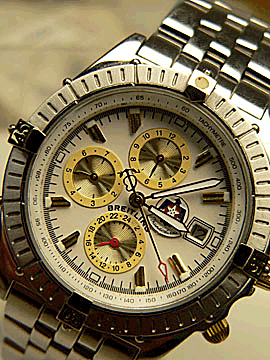 A
watch is a timepiece that is today worn on the wrist with a band
or bracelet. They evolved in the 17th century from
spring-powered clocks. Besides telling time, some also display the day,
date, month and year, plus other functions on more sophisticated
electronic models. Most have quartz movements. Expensive watches often have mechanical movements powered by
springs, even though these movements are less accurate than quartz
ones.
A
watch is a timepiece that is today worn on the wrist with a band
or bracelet. They evolved in the 17th century from
spring-powered clocks. Besides telling time, some also display the day,
date, month and year, plus other functions on more sophisticated
electronic models. Most have quartz movements. Expensive watches often have mechanical movements powered by
springs, even though these movements are less accurate than quartz
ones.But before people could purchase inexpensive quartz watches in
the 20th century, most men owned pocket watches, which often had
covers. They carried them in a vest pocket, attached to a watch
chain and fob.
A watch movement is the mechanism that measures the passage of
time and displays the current time, plus the date, and sometimes
month and day. They can be entirely mechanical, entirely
electronic, or a combination of of the two. Most of today’s watches
have electronic movements, with mechanical hands on the face of
the watch to tell the time. These movements employ an escapement mechanism to control and limit the unwinding of the
spring, converting what would otherwise be a simple unwinding,
into a controlled and periodic energy release. They also employ a
balance wheel which includes a hairspring to control motion of the
gear system of the watch much like a pendulum in a clock.
A self-winding or automatic mechanism is one that rewinds the
mainspring of a mechanical movement by the natural motions of the
wearer's body. Abraham-Louis Perrelet invented the first
self-winding mechanism for pocket watches in 1770, but it wasn’t
until British watchmaker John Harwood invented the first
"self-winding" or "automatic" wristwatch in
1923 that the modern wristwatch came into its own.
Electronic watch movements use a tiny quartz crystal which
forms an oscillator which resonates at a specific and stable frequency, and which watchmakers use to accurately pace
today’s timepieces.
Learn what to look for when buying a watch.
Find out what's inside a watch.
Find out what you should know about watch batteries.
Learn how to correct for
Daylight Saving Time.
Read about pocket watches.
Learn about the Waterbury Watch.
Find out about the origin of the railroad watch.
Read about collecting watches.
Read about watch papers.
Read about collecting pocket watch holders.
